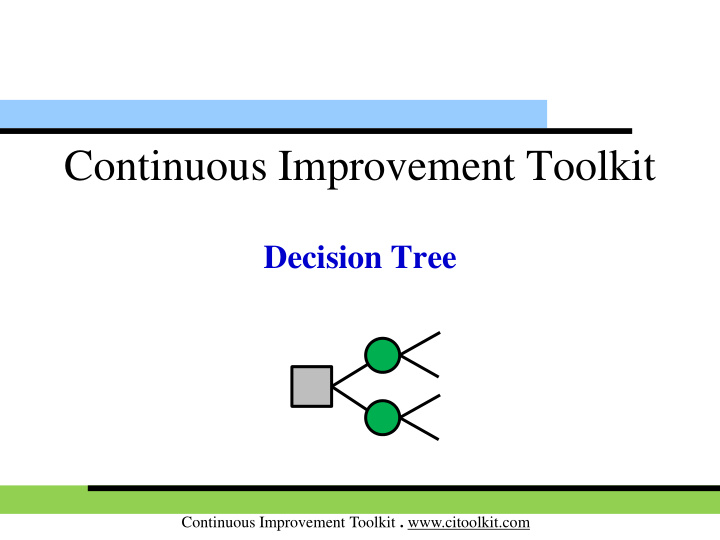



Continuous Improvement Toolkit Decision Tree Continuous Improvement Toolkit . www.citoolkit.com
Managing Deciding & Selecting Planning & Project Management* Pros and Cons Risk PDPC Importance-Urgency Mapping RACI Matrix Stakeholders Analysis Break-even Analysis RAID Logs FMEA Cost -Benefit Analysis PEST PERT/CPM Activity Diagram Force Field Analysis Fault Tree Analysis SWOT Voting Project Charter Roadmaps Pugh Matrix Gantt Chart Decision Tree Risk Assessment* TPN Analysis Control Planning PDCA Matrix Diagram Gap Analysis QFD Traffic Light Assessment Kaizen Prioritization Matrix Hoshin Kanri Kano Analysis How-How Diagram KPIs Lean Measures Paired Comparison Tree Diagram** Critical-to Tree Standard work Identifying & Capability Indices OEE Pareto Analysis Cause & Effect Matrix Simulation TPM Implementing RTY MSA Descriptive Statistics Understanding Confidence Intervals Mistake Proofing Solutions*** Cost of Quality Cause & Effect Probability Distributions ANOVA Pull Systems JIT Ergonomics Design of Experiments Reliability Analysis Hypothesis Testing Graphical Analysis Work Balancing Automation Regression Scatter Plot Understanding Bottleneck Analysis Correlation Run Charts Visual Management Chi-Square Test Multi-Vari Charts Performance Flow 5 Whys 5S Control Charts Value Analysis Relations Mapping* Benchmarking Fishbone Diagram SMED Wastes Analysis Sampling TRIZ*** Focus groups Brainstorming Process Redesign Time Value Map Interviews Analogy SCAMPER*** IDEF0 SIPOC Nominal Group Technique Photography Mind Mapping* Value Stream Mapping Check Sheets Attribute Analysis Flow Process Chart Process Mapping Measles Charts Affinity Diagram Surveys Data Visioning Flowcharting Service Blueprints Lateral Thinking Critical Incident Technique Collection Creating Ideas** Designing & Analyzing Processes Observations Continuous Improvement Toolkit . www.citoolkit.com
- Decision Tree The aim is to identify those actions which will give the best results. It enables a thorough mapping of all decisions and their possible outcomes . Originated in financial and marketing, although it can be used for many other situations. Valuable for evaluation different capacity expansion alternatives when demand is uncertain and sequential decisions are involved. Continuous Improvement Toolkit . www.citoolkit.com
- Decision Tree Used to: Help you make choices between different paths and outcomes. Select from a number of possible actions. Make important or complex decisions. Identify the effects of actions or risks. Help you make all kinds of business decisions, such as: • New product development. • New marketing strategies. • Workforce changes. Continuous Improvement Toolkit . www.citoolkit.com
- Decision Tree Approach: Start with the decision that you need to make. Then draw out lines for each possible action/decision. At the end of each line consider: • A condition (uncertain). • A result / a decision (certain). Keep doing this until you are confident you have identified as many of the possible outcomes leading from the original decisions. Continuous Improvement Toolkit . www.citoolkit.com
- Decision Tree Example: Decide whether a person should be offered a loan Offer a loan? Black listed? Yes No No Loan Income Range of Applicant > 50,000 =< 50,000 Years in present job Loan Less than 2 2 years or more No Loan Loan Continuous Improvement Toolkit . www.citoolkit.com
- Decision Tree Provide a Loan? No Loan Loan Decisions Uncertain outcomes Or external event No Loan Loan Continuous Improvement Toolkit . www.citoolkit.com
- Decision Tree Example: When to buy? Cost 1: Cost 2: Event / Event (Cost) Item cost =< $1 Item cost > $1 Buy 200 Buy 100 1: Level stock =< 100 Buy 100 Search alternatives 2: Level stock >100 Item cost =< $1 Buy 200 Level stock =< 100 Buy 100 Item cost > $1 Buy? Item cost =< $1 Buy 100 Level stock >100 Search alternatives Item cost > $1 Continuous Improvement Toolkit . www.citoolkit.com
- Decision Tree Example: Return on advertisement campaign E1 (0.7): E2 (0.3): Action / Event Rising market Falling market 24K 8K A1: Prime-time spread 18K 17K A2: Targeted sectors 14K 22K A3: Low-level 24K E1 (0.7) A1 8K E2 (0.3) E1 (0.7) 18K A2 How to advertise? E2 (0.3) 17K A3 14K E1 (0.7) 22K E2 (0.3) Continuous Improvement Toolkit . www.citoolkit.com
- Decision Tree Example - What Product to Produce? 1 st Decision Point 2 nd Decision Point 25K Favorable market (0.7) 20,500 10K Which Product? Unfavorable market (0.3) 33K Favorable market (0.7) 29,700 Unfavorable market (0.3) 22K Market survey? 20K Favorable market (0.9) 18,500 5K Unfavorable market (0.1) 28K Favorable market (0.9) 26,900 Unfavorable market (0.1) 17K Continuous Improvement Toolkit . www.citoolkit.com
Recommend
More recommend